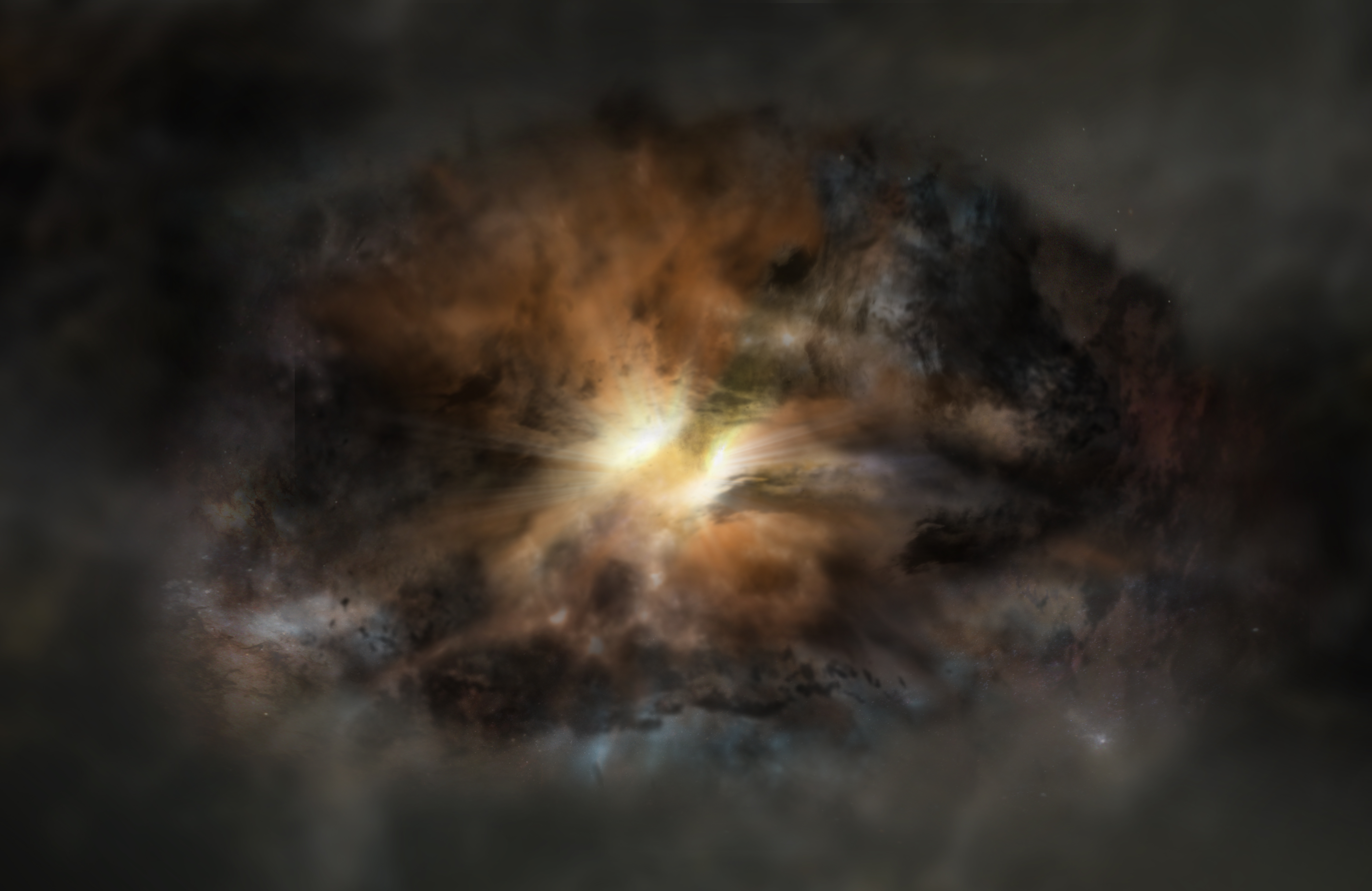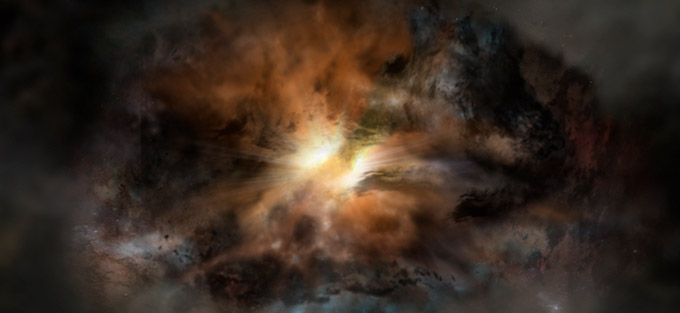Chaotic Turbulence Roiling 'Most Luminous Galaxy' in the Universe
The most luminous galaxy in the Universe –a so-called obscured quasar 12.4 billion light-years away – is so violently turbulent that it may eventually jettison its entire supply of star-forming gas, according to new observations with the Atacama Large Millimeter/submillimeter Array (ALMA).
A team of researchers used ALMA to trace, for the first time, the actual motion of the galaxy's interstellar medium – the gas and dust between the stars. What they found, according to Tanio Díaz-Santos of the Universidad Diego Portales in Santiago, Chile, and lead author of this study, is a galaxy "so chaotic that it is ripping itself apart."
Previous studies with NASA's Wide-field Infrared Survey Explorer (WISE) spacecraft reveal that the galaxy, dubbed W2246-0526, is glowing in infrared light as intensely as approximately 350 trillion suns.
Evidence strongly suggests that this galaxy is actually an obscured quasar, a very distant galaxy withcontains a voraciously feeding supermassive black hole at its center that is completely obscured behind a thick blanket of dust.
This galaxy's startling brightness is powered by a tiny, yet incredibly energetic disk of gas that is being superheated as it spirals in on the supermassive black hole. The light from this blazingly bright accretion disk is then absorbed by the surrounding dust, which re-emits the energy as infrared light.
"These properties make this object a beast in the infrared," said Roberto Assef, an astronomer with the Universidad Diego Portales and leader of the ALMA observing team. "The powerful infrared energy emitted by the dust then has a direct and violent impact on the entire galaxy, producing extreme turbulence throughout the interstellar medium."

The astronomers compare this turbulent action to a pot of boiling water. If these conditions continue, they say, the galaxy's intense infrared radiation would boil away all of its interstellar gas.
This galaxy belongs to a very unusual type of quasar known as Hot, Dust-Obscured Galaxies or Hot DOGs. These objects are very rare; only 1 out of every 3,000 quasars observed by WISE belong to this class.
The research team used ALMA to precisely map the motion of ionized carbon atoms throughout the entire galaxy. These atoms, which are tracers for interstellar gas, naturally emit infrared light, which becomes shifted to millimeter wavelengths as it travels the vast cosmic distances to Earth due to the expansion of the Universe.
"Large amounts of ionized carbon were found in an extremely turbulent dynamic state throughout the galaxy," Díaz-Santos describes. The data reveal that this interstellar material is careening anywhere from 500 to 600 kilometers per second across the entire galaxy.
The astronomers believe that this turbulence is primarily due to the fact that the region around the black hole is at least 100 times more luminous than the rest of the host galaxy combined; in other quasars, the proportion is much more modest. This intense yet localized radiation exerts tremendous pressure on the entire galaxy, to potentially devastating effect.
"We suspected that this galaxy was in a transformative stage of its life because of the enormous amount of infrared energy discovered with WISE," said Peter Eisenhardt with NASA's Jet Propulsion Laboratory in Pasadena, California, and scientific leader of the WISE mission. "Now ALMA has shown us that the raging furnace in this galaxy is making the pot boil over."
Current models of galactic dynamics combined with the ALMA data indicate that this galaxy is unstable and its interstellar gas is being blown away in all directions. This means that the galaxy's Hot DOG days are numbered as it matures into a more traditional unobscured quasar.
"If this pattern continues, it is possible that in the future W2246 ends up shedding a large part of the gas and dust it contains," concludes Manuel Aravena also from the Universidad Diego Portales, and co-author of the study. "Only ALMA, with its unparalleled resolution, can allow us to see this object in high definition and fathom such an important episode in the life of this galaxy."
This article, "The Strikingly Uniform, Highly Turbulent Interstellar Medium of The Most Luminous Galaxy in the Universe,” will be published in the Astrophysical Journal Letters.
Adittional information
The Atacama Large Millimeter/submillimeter Array (ALMA), an international astronomy facility, is a partnership of the European Organisation for Astronomical Research in the Southern Hemisphere (ESO), the U.S. National Science Foundation (NSF) and the National Institutes of Natural Sciences (NINS) of Japan in cooperation with the Republic of Chile. ALMA is funded by ESO on behalf of its Member States, by NSF in cooperation with the National Research Council of Canada (NRC) and the Ministry of Science and Technology (MOST) in Taiwan and by NINS in cooperation with the Academia Sinica (AS) in Taiwan and the Korea Astronomy and Space Science Institute (KASI).
ALMA construction and operations are led by ESO on behalf of its Member States; by the National Radio Astronomy Observatory (NRAO), managed by Associated Universities, Inc. (AUI), on behalf of North America; and by the National Astronomical Observatory of Japan (NAOJ) on behalf of East Asia. The Joint ALMA Observatory (JAO) provides the unified leadership and management of the construction, commissioning and operation of ALMA.
Contacts
Tanio Díaz Santos
Núcleo de Astronomía, Facultad de Ingeniería
Universidad Diego Portales, Santiago, Chile
Tel: +56 2 2213 0480
Email: [email protected]
Valeria Foncea
Education and Public Outreach Officer
Joint ALMA Observatory
Santiago, Chile
Tel: +56 2 467 6258
Cell: +56 9 75871963
Email: [email protected]
Charles E. Blue
Public Information Officer
National Radio Astronomy Observatory
Charlottesville, Virginia, USA
Tel: +1 434 296 0314
Cell: +1 434.242.9559
E-mail: [email protected]
Richard Hook
Public Information Officer, ESO
Garching bei München, Germany
Tel: +49 89 3200 6655
Cell: +49 151 1537 3591
Email: [email protected]
Masaaki Hiramatsu
Education and Public Outreach Officer, NAOJ Chile
Observatory
Tokyo, Japan
Tel: +81 422 34 3630
E-mail: [email protected]


